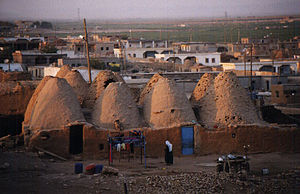The next morning we saw Urfa, and it was like having left the country – very middle-east; little Turkish spoken; Kurdish and Arabic; covered women; men wearing baggy pan

ts. First impression is how beautiful it all is. There’s a wonderful section of narrow streets with medieval houses with lattice-windowed overhangs; over the doors were pictures signifying which houses had members who went on Hajj (to Mecca). But the surprise was how welcoming the place was, rare for such a religious area. An elementary school principal spotted us on the street and insisted we come in and drink smuggled Syrian tea with him. When we finally escaped from his school, we went to Abraham’s Cave (Hz. Ibrahim Magalar), where Abraham supposedly was born and spent his first ten years hiding from the local Assyrian tyrant Nemrut. Both Jewish and Muslim texts have Abraham living here and being told by God to take his family to Canaan. Since he’s also considered a Muslim prophet, the entrances to the cave were separated, Elif had to cover her head, people were bowing down in there quite vigorously, and it stank.
From there we crossed to Golbasi, a park with two mosques and three pools loaded with carp (Balikligol). The story is this: Abraham came out of his cave and then defied King Nemrut, trying to smash the idols in the local temple. This irked Nemrut to no small degree, and he slingshotted (or threw) Abe from the columns of the castle (Mancinik) into a fire below. But God wasn’t going to sit by and let all this go unnoticed, so He turned the flames into water and the firewood into carp. By the water, a girl wearing a Mickey Mouse shirt asked us if we would convert to Islam. Elif had a nice talk with her, telling her that if the were super-nice to foreigners they’d appreciate how great Muslims were.
From there we went to Urfa’s Kapalipazari/Bitpazari, the bazaars, where I snapped roll after roll of pictures of people. Isik (E’s stepmother) and Elif bought traditional eastern headcoverings from a very old man, who was very nice and showed them how to wrap them on, but asked Isik, “Do they all dress as open as you in Istanbul?” Isik: “Even more so.” Old guy: “But aren’t you all afraid of the other world?” Elif: “No, because our hearts are pure.” Everyone was very, very nice to me. A bunch of kids selling tobacco made me sit down and smoke it with them. Two men playing Turkish dominoes made me come over and play a game with them. (Pieces move like a chess rook rather than a chess bishop, which confused the hell out of me, along with other rules.) Everyone loves Ibrahim Tatlises, a Turkish superstar from Urfa who is the godfather of arabesque but now sings folk songs; he’s so tied in with the mafia that he’s basically the Turkish Frank Sinatra. One of the domino players confessed to me that he plays tapes of Tatlises every night and cries to them. I’ve seen Tatlises concerts on TV, where you can spot audience members cutting their arms with razor blades. Anyway, I was having lots of fun. I tried on baggy pants, which didn’t look good on me at all, but E looked great in them and bought a pair. We bought a rug made out of sweat – you lay the wool in a hamam and lots of Mustafas dive on top of them, flattening them out to their current design – which will hang on our wall. I went into the cave where the wool was spun, but only for a second to snap off some photos, as any longer would have given me black lung disease. And we all drank meyan koku from a guy walking around selling it from a bagpipe-like bladder strapped on his back, with holders for glasses, which he cleaned by dipping them in water; meyan koku is made out of some root and tastes like bitter earth, horrible really, but has an aftertaste sweeter than sasparilla. We bought some root; the recipe: 250 grams koku, 2 liters water, 1 tsp. baking soda, dash bit cinnamon; wait; strain. We also drank mirra, a local espresso that tasted like strong and burnt coffee gone sour. To make it, use ½-ground coffee, boil for ½ hour, let cool for ½ hour, and skim the top.
We drove 45km southeast to Harran, where they have these amazing wood-less gumdrop beehive-style houses. Abraham (unlike George Washington and Edgar Allen Poe) slept there on the way from Urfa to Canaan. It’s one of the oldest settlements on earth and looks like it must have looked 6000 years ago; Arabs and Kurds smuggling sheep from the Syrian border 10km to the south. When we arrived, children came from everywhere to be our guides. There was no getting rid of them. They had a minaret of Ulu Cami, built in the 700’s; a Crusader fortress from the 11th century; an astronomy kulesi tower; and a Harran Universitesi arch. It was all gone and abandoned, like a lot of the stuff near Armenia. One of the girls begging and following and being our “guide” was so strikingly beautiful, it was like that National Geographic girl from Afghanistan years ago. I wasted a half roll trying to get her picture; she was very shy. One beehive house had an Arab with 14 children, and the Arab had lots of Arabic costumes, which we put on in the amazing heat and played dress-up and took pictures of each other. Here’s Kadri and me, looking like stern semitics: bonding.
(People I played dominoes with in Urfa: Mahmut C*akalli* and Yusuf Usul mahmutsavak@hotmail.com, Yusuf_usul@hotmail.com)